Volcanos
Note: If you are interested in learning more
about volcanos than can be learned in the single lecture on this topic, consider
taking the 1-credit class Geology 111 "Volcanos and civilization" offered
annually in this department.
I. Types of volcanos
- Stratovolcano (composite cone)
- Shield volcano
- Cinder cone (tephra cone)
- Dome volcano
- Fissures
II. Locations of volcanism
- Seafloor spreading centers
- Subduction zones
- Continental rifts
- Hotspots and flood basalts
III. Building and destroying volcanos
- Building from the top
- Caldera collapse, mass wasting, and
erosion
Although most mountain ranges are formed
in response to tectonic plate convergence, another geologic process, volcanism, builds topography in a completely
different way. Volcanic topography is built by the extrusion onto the
earth's surface of molten material called lava. Volcanos are thus not built
by faulting and folding (rock deformation), as are other high topographic
features. The material below provides basic information about the principal
types of volcanos and their principal characteristics.
I. Viscosity and types of volcanos
There are five principal types of volcanos if we
categorize them by their shapes, as follows: (1) Stratovolcanos, also known as
composite cones, (2) cinder cones, (3) dome volcanos, (4) shield volcanos, and
(5) fissures. The most important factor in determining the shape or type of
volcano is the
viscosity
of the magma that builds the volcano.
Viscosity
is a measure of a fluid material's resistance to flow and results from the internal forces
and friction between the material's molecules. Materials with low viscosity have
low resistance to flowing and therefore flow very easily. Conversely, materials with
high viscosity resist flowing and thus flow very slowly. For a few examples, air is
a very low viscosity material. Water flows easily, but is about 100 times more
viscous than air. Motor oil is about 1000 times more viscous than water.
The lowest viscosity magmas, which are basaltic in composition, have viscosities
that are as much as 10 billion times lower than the highest viscosity magmas,
which are rhyolitic in composition. This surprisingly large variation in resistance
to flow between different types of magmas is caused by two factors, variations in their
temperatures and variations in their concentration of silica. The influence of
temperature on viscosity is intuitive - consider for example the tendency of hot wax
to flow much faster than cool wax, or hot maple syrup to flow faster than cold syrup.
In general, increasing the temperature of a fluid lowers its viscosity, therefore,
magma bodies with higher temperatures flow more readily.
The primary control on a magma's viscosity is its concentration of silica molecules.
Silica molecules in a magma body tend to bind together in ever larger molecular
chains that eventually form the lattices of various minerals when the magma begins
to cool. As these multiple-silica molecules increase in number and size within a
magma body, they increase the internal
forces that resist movement between the molecules within the magma and therefore
increase resistance to flow. It thus follows that magmas with higher concentrations
of silica have higher viscosities. A typical basaltic magma, which comes from
partial melting of the mantle beneath oceanic crust or mantle beneath continental
crust, has a silica concentration of about 50%. In contrast, rhyolitic magmas, which
are generated by partial melting within continental crust, have silica concentrations
of about 70%.
The differences in the viscosities of magmas determine both the shape and explosivity
of the volcanos that they form. Low viscosity, basaltic magmas can flow long distances
on a landscape before they solidify and therefore give rise to volcanos with very
low slopes, known as shield volcanos.
Beneath the ocean, basaltic volcanism along
seafloor spreading centers builds shield volcanos or sheets of basaltic rocks where
the magmas are extruded along fissures. Gases escape easily from these hot, low viscosity
magmas and the eruption hazard and ash output is thus very low. Higher viscosity magmas
build cinder cones and
stratovolcanos,
which have steep sides since their extrusives
solidify quickly once they reach the surface and move away from their central vent.
Such volcanos have high explosive hazard since gases within them cannot escape the
sticky magma easily. The highest viscosity, coolest magmas build
dome volcanos, which
are very steep sided and expand slowly outward onto a landscape. Examples of each are
shown below.
- Stratovolcano or composite
cone - a volcano that consists of intermixed layers of lava flows and
poorly consolidated volcanic material such as ash and cinders. Stratovolcanos
are typically located on continental crust above subducting plates and are
easily recognized by their often beautiful symmetrically-shaped cones. They
have also been responsible for the largest, most destructive historic eruptions
due to retention and build-up of volatile gases within the volcanos and their
magmas during their pre-eruptive phases. During any given year, a few dozen
stratovolcanos are active, and around 500 have erupted during historic times.
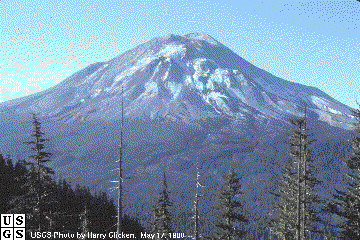 Mount St. Helens before the May
18, 1980 eruption
Mount St. Helens before the May
18, 1980 eruption
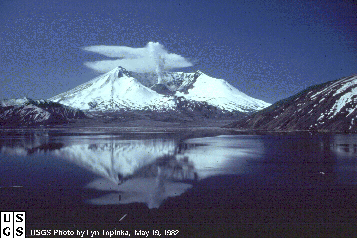 Mount St Helens after May 18, 1980
Mount St Helens after May 18, 1980
Mount St. Helens is a classic stratovolcano that is one of the Cascade
volcanos in the Pacific Northwest. Located above the subducting Juan
de Fuca plate, the volcano had a catastrophic eruption on May 18, 1980.
The eruption blew off the upper 1300 feet of the volcano, devastated the surrounding
forest, rivers, and lakes, and spread ash over several states.
Since 1980, a small lava dome has pushed upward inside the crater. You
can see steam coming from it in the graphic above. The graphic below
shows a close-up of this volcanic "plug".
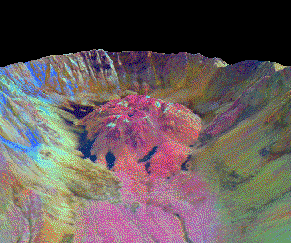 Post-eruption dome in crater of
Mount St. Helens Oregon
Post-eruption dome in crater of
Mount St. Helens Oregon
The following figures show Volcan Fuego
de Colima in western Mexico, an Aleutian island stratovolcano, and Mt. Fuji
of Japan.
 Volcan Fuego de Colima, Mexico
Volcan Fuego de Colima, Mexico
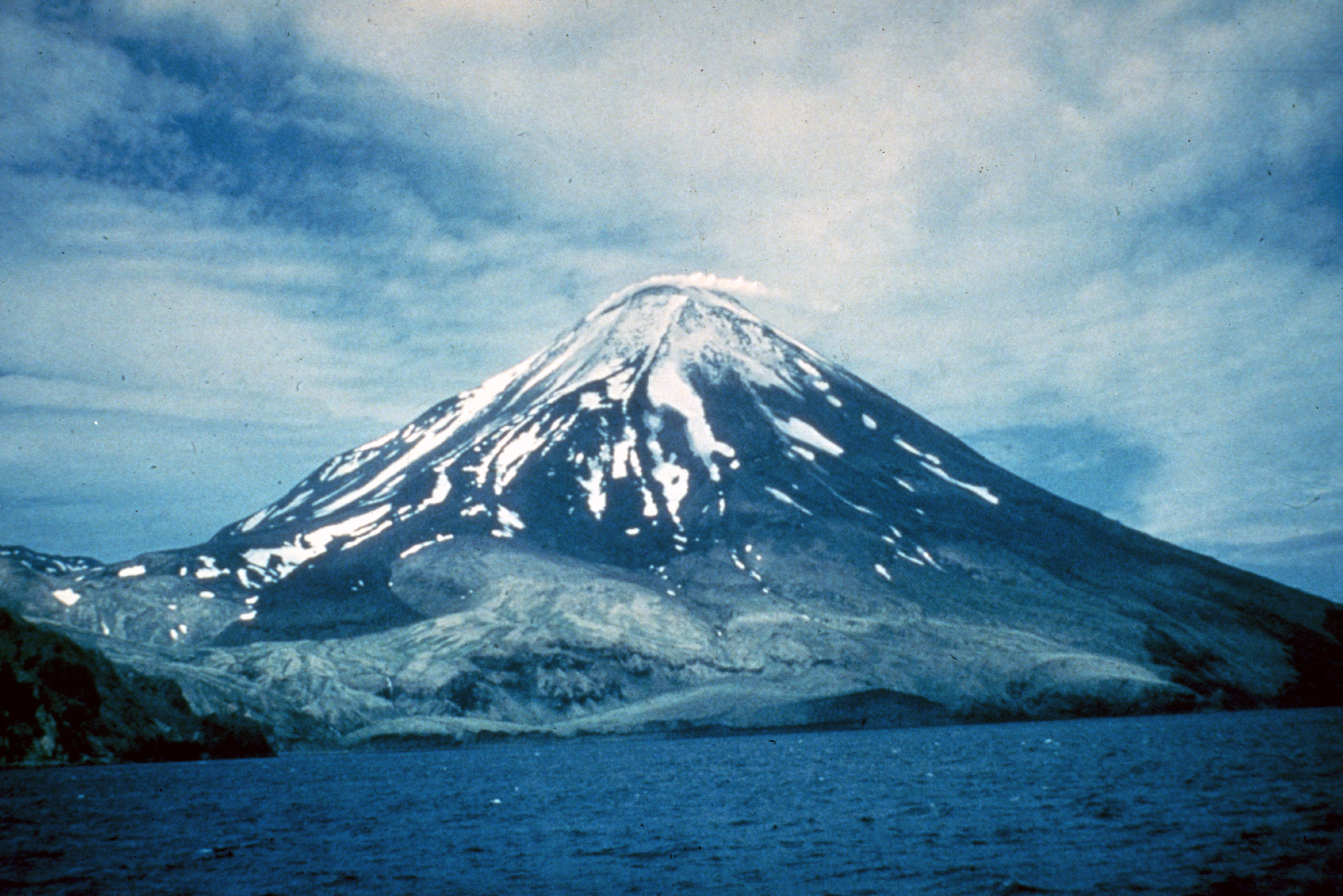 Aleutian
island stratovolcano
Aleutian
island stratovolcano
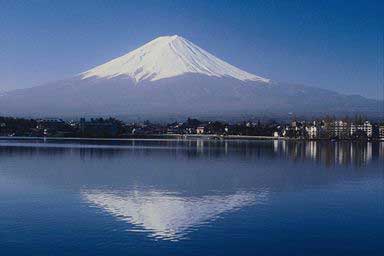 Mt. Fuji, Japan
Mt. Fuji, Japan
The symmetric shapes of these volcanos comes
from the fact that they are built from the top downwards by loose ash and
pyroclasts
that accumulate and roll down the steep flanks of the volcano. Occasional
lava flows come from the crater on the top - these flow down the steep slopes
and solidify on top of the loose ash and pyroclasts. Because stratovolcanos
are built of this mixture of unconsolidated pyroclastic material and lava
flows, they are one of Mother Nature's less stable constructs (particularly
when they grow to heights that exceed ten thousand feet). The relatively
steep-sided nature of stratovolcanos is a by-product of the relatively
viscous
magmas that build them. The lavas simply cannot flow very far once they
are erupted, so they cool and solidity close to the erupting vent and build
a steeper-sided cone than would a less viscous magma. Retention of
volatile gases is another important characteristic of viscous magmas and hence
stratovolcanos. The increase in gas pressure within a volcano prior
to an eruption is one reason that stratovolcanic eruptions can be so dangerous.
More than 500
stratovolcanos have erupted in historic times and in any given year, several
dozen are active. The photo below of Mount Pinatubo in the Philippines
shows its massive eruption in 1991.
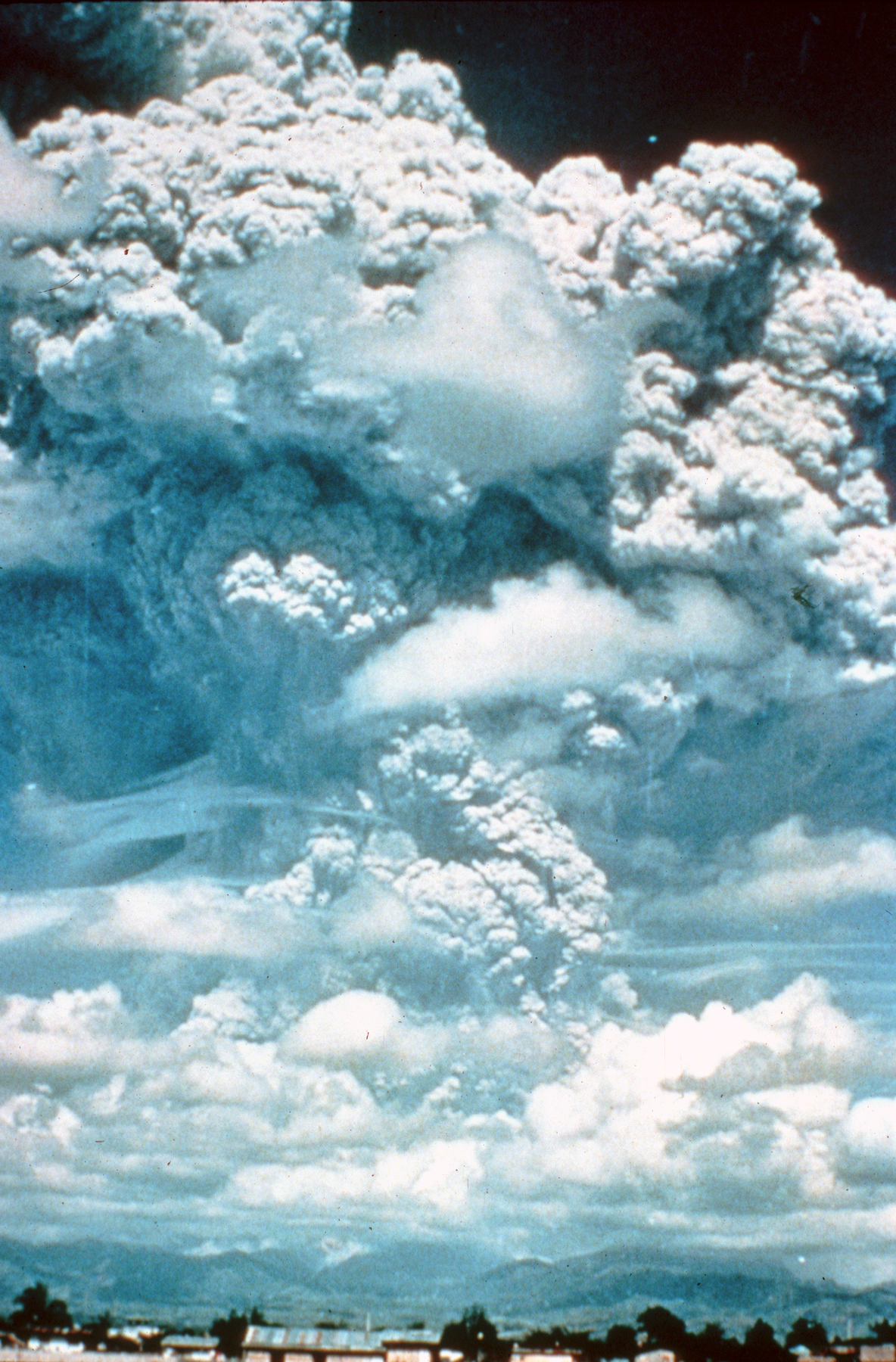 Mount
Pinatubo, Philippines, 1991
Mount
Pinatubo, Philippines, 1991
- Shield
volcano
Shield volcanos
gained their name from the fact that their profile against the horizon looks
like a shield laying on the ground. The flanks of a shield volcano have low
slopes, sometimes only a few degrees from horizontal. Shield volcanos are
the largest volcanic features on earth - the largest shield volcano, Mauna
Loa in the Hawaiin Islands, has a volume 300 times greater than that of the
largest stratovolcano, Mount Fuji in Japan. Shield volcanos are created
through the eruption of basaltic magmas, which flow easily and thus are capable
of flowing over the landscape many miles from the central fissures or vents.
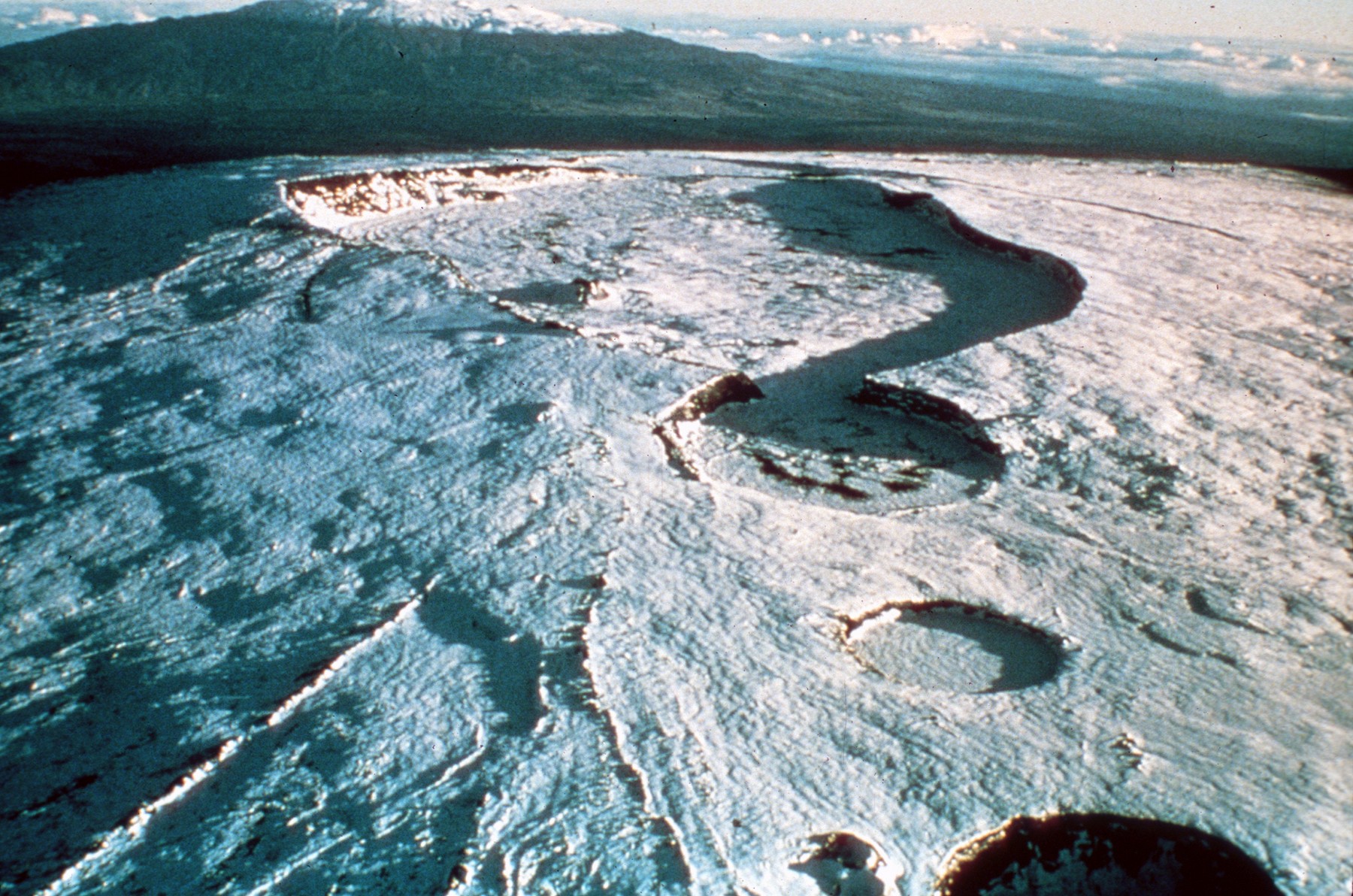 Shield
volcanos in the Galapagos, Ecuador. Note profile of another shield volcano
in the distance.
Shield
volcanos in the Galapagos, Ecuador. Note profile of another shield volcano
in the distance.
- Cinder cone (tephra
cone)
This type of volcano
consists almost entirely of tephra, which is another term used for
a pyroclast. From a distance, cinder cones resemble piles of sand because
they are made almost entirely of loose material that has rained down from
their central vent. These cones usually erupt lava flows, too. Flows
associated with cinder cones usually emerge from the base of the cone rather
than the crater on the top. These basal flows occur because the loosely
piled cinders that make up the cone are too weak to resist the outward pressure
that a rising lava flow exerts on the sides of the central vent of the volcano.
The lava is thus able to push its way outward through the cinders near the
base of the cone. Overall, Earth has approximately 10,000-20,000 active cinder cones,
many of which are clustered on or near other types of active volcanos.
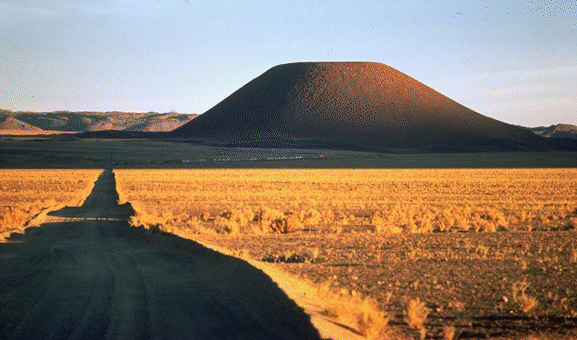 La Poruna monogenetic cinder cone, northern Chile
La Poruna monogenetic cinder cone, northern Chile
Monogenetic cinder cones are products
of single eruptions that last from several hours to several years. They are
typically several hundred meters high and have distinct geometric forms with
slopes of 33 degrees. See the train in the shadow of the cone for scale.
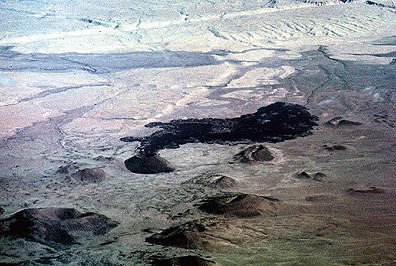 Cinder cone field with flow
Cinder cone field with flow
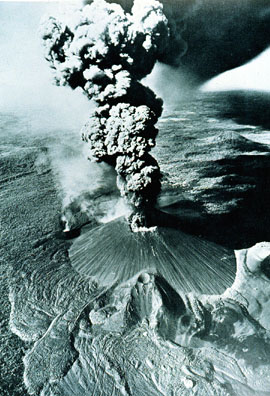 Erupting cinder cone
Erupting cinder cone
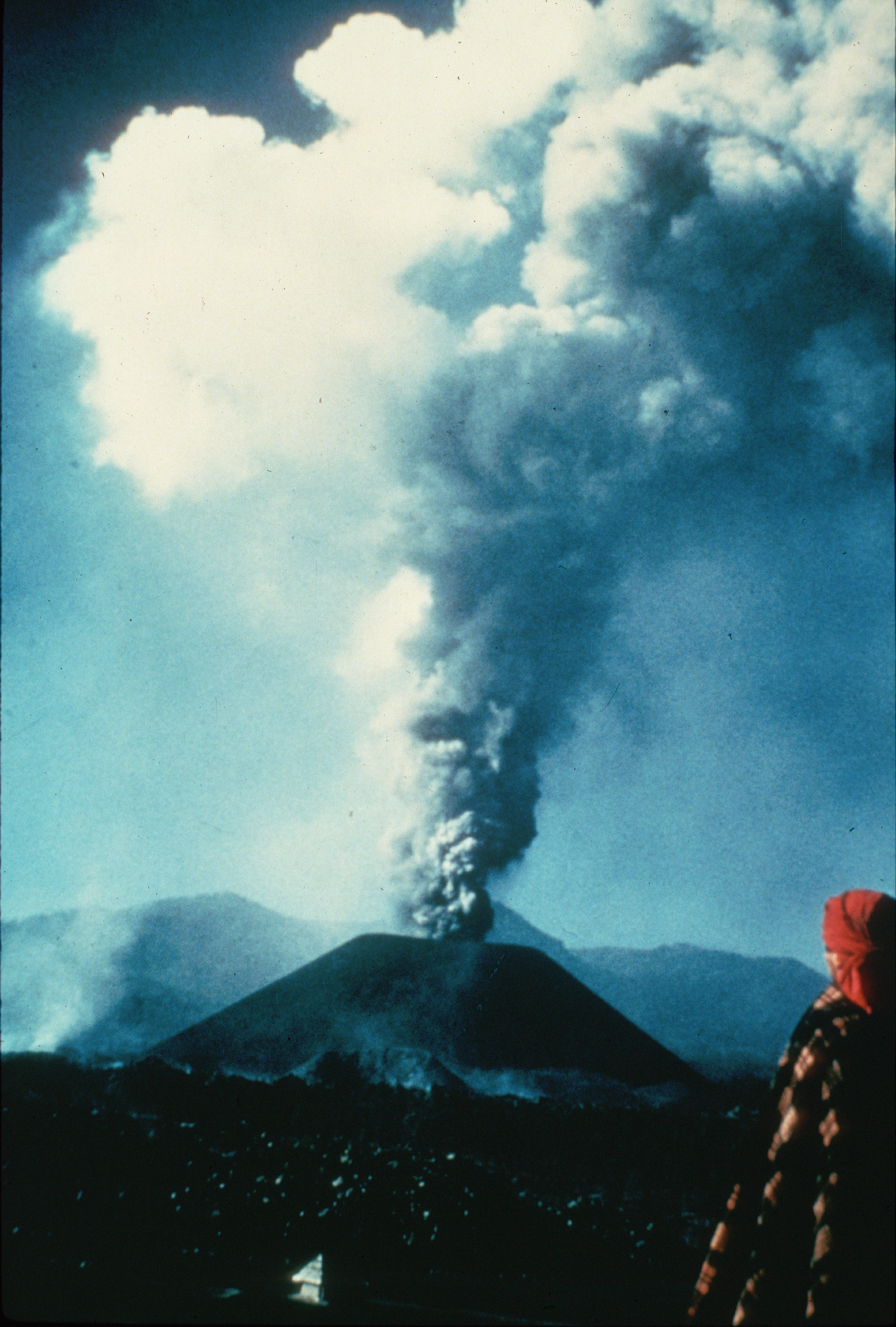 This image shows the Paricutin cinder cone of western Mexico.
This cinder cone was "born" on Feb. 20, 1943, in the field of a poor Mexican
peasant who was planting corn when he saw flames begin shooting out of
a nearby crack in the ground. Within several years, Paricutin grew to a height of
more than 1000 feet years. For a time, it was Mexico's main tourist attraction.
Although Paricutin's eruptions consisted mainly of cinders for several years,
it eventually emitted a lava flow that covered dozens of square miles of the
surrounding countryside. Only nine years after eruptions initiated, Paricutin
went extinct and has remained inactive since 1952.
This image shows the Paricutin cinder cone of western Mexico.
This cinder cone was "born" on Feb. 20, 1943, in the field of a poor Mexican
peasant who was planting corn when he saw flames begin shooting out of
a nearby crack in the ground. Within several years, Paricutin grew to a height of
more than 1000 feet years. For a time, it was Mexico's main tourist attraction.
Although Paricutin's eruptions consisted mainly of cinders for several years,
it eventually emitted a lava flow that covered dozens of square miles of the
surrounding countryside. Only nine years after eruptions initiated, Paricutin
went extinct and has remained inactive since 1952.
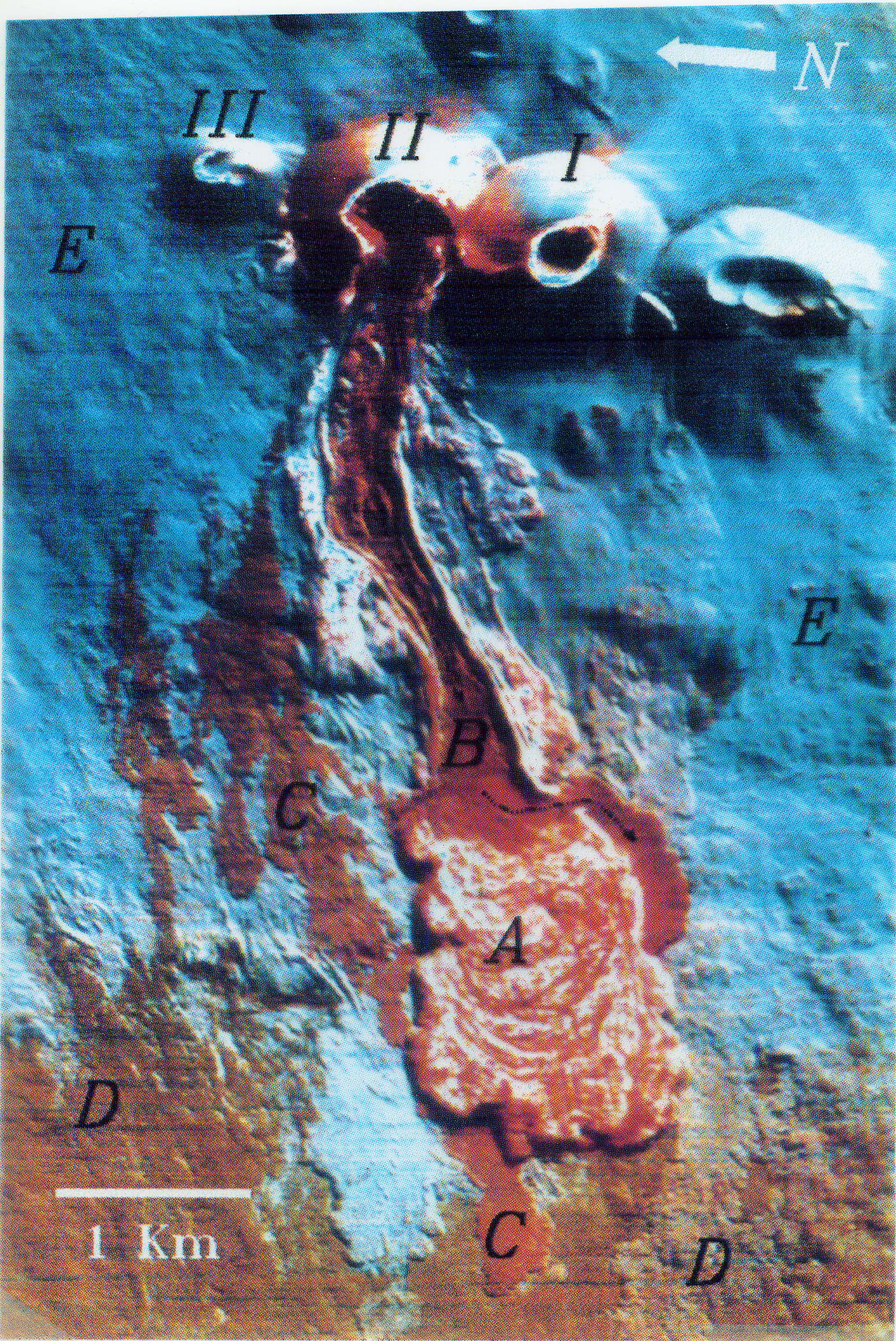 Satellite radar image of cinder cones in the Kamchatka
peninsula, Russia. Recent lava flows (now hardened) are exhibited by
reddish colors. The cones looks smooth because the radar waves that
are used to image them cannot image the individual cinders. In aggregate,
the numerous small cinders instead look like a smooth surface to the radar
wave.
Satellite radar image of cinder cones in the Kamchatka
peninsula, Russia. Recent lava flows (now hardened) are exhibited by
reddish colors. The cones looks smooth because the radar waves that
are used to image them cannot image the individual cinders. In aggregate,
the numerous small cinders instead look like a smooth surface to the radar
wave.
Dome volcanos typically
form from sticky viscous magmas that are squeezed onto the surface. Small
dome volcanos often extrude up the throat of a stratovolcano after it has
a major eruption (see the figure above of the dome volcano inside the Mt.
St. Helens crater).
Dome volcanos are less
common than cinder cones. Below is an image of the Mono Craters in
California. The viscous lava that was extruded from the subsurface
magma chamber was unable to flow very far before it hardened. The steep
slopes on the side of these flows are one result of the viscous magma.
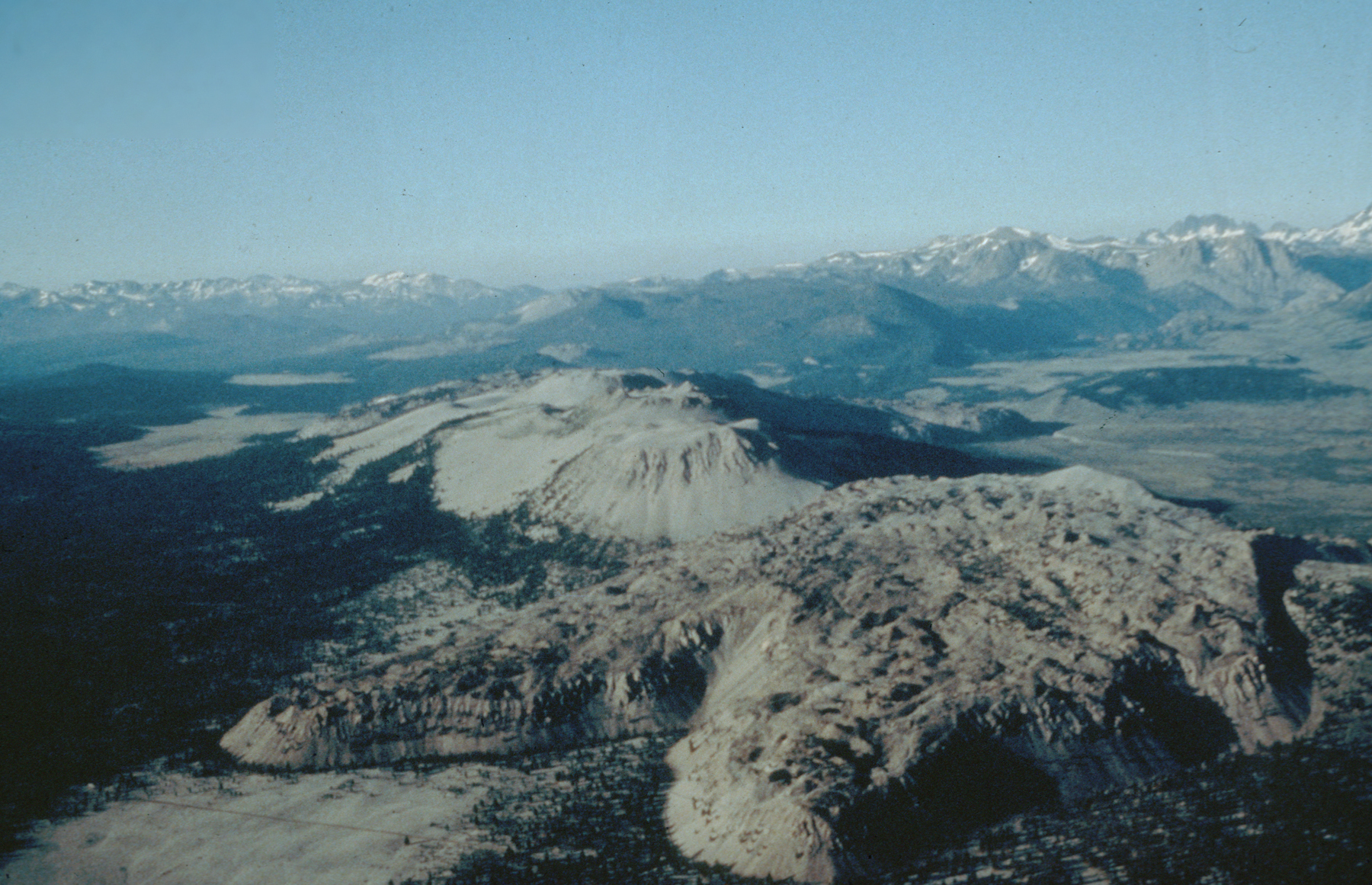 Mono Craters, California
Mono Craters, California
Fissure eruptions occur
along linear rifts in the surface. Fissure eruptions on land are rare outside
of Hawaii and Iceland; however, new seafloor is created through fissures that
are located along the axis of a seafloor spreading center. More volcanic rock
is extruded each year by fissure eruptions along seafloor spreading centers
than by any other type of volcanism.
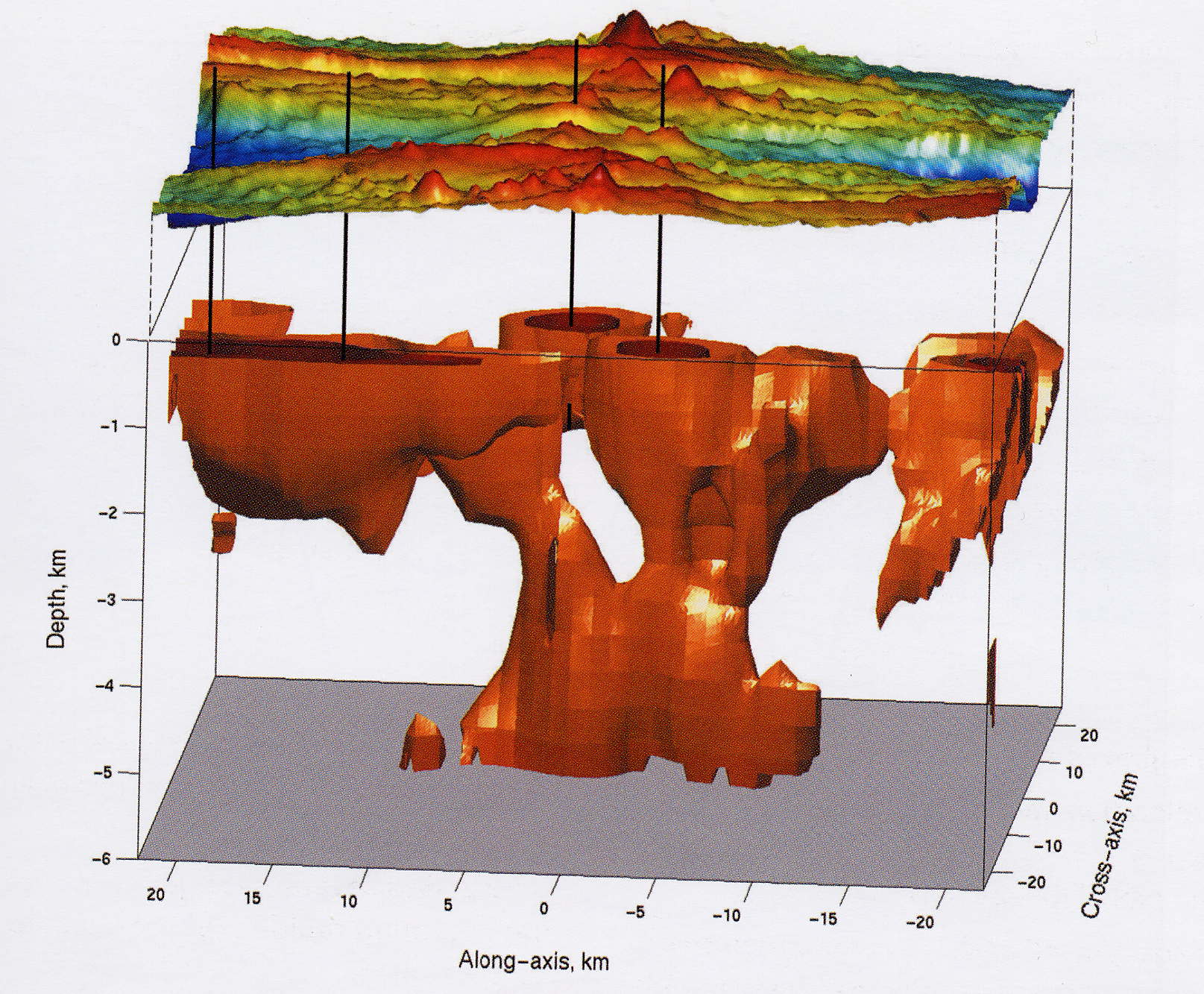
Vertical view of
a seafloor spreading center (upper colored area) and areas of anomalously
warm mantle beneath the axis of seafloor spreading. Fissure eruptions
occur along the rift located at the highest point (red color) in the seafloor.
The plumbing of the magma system beneath the spreading center is presumably
shown by the areas of anomalously warm mantle. From the RIDGE report,
2004.
II. Volcano locations
Ignoring volcanism that
occurs along mid-ocean ridges, volcanos appear in a variety of geologic settings.
Volcanoes occur most often above subducting slabs, and additionally occur
in zones of crustal extension where faulting presumably provides a conduit
for magma to reach the surface. In ocean basins, thousands of seamounts
have been formed over the past 200 million years as oceanic plates have drifted
over assorted mantle hotspots. These volcanos mark the trace of a plate
as it drifts steadily over the hotspot, which is fixed (or nearly so) in
the mantle beneath the plate.
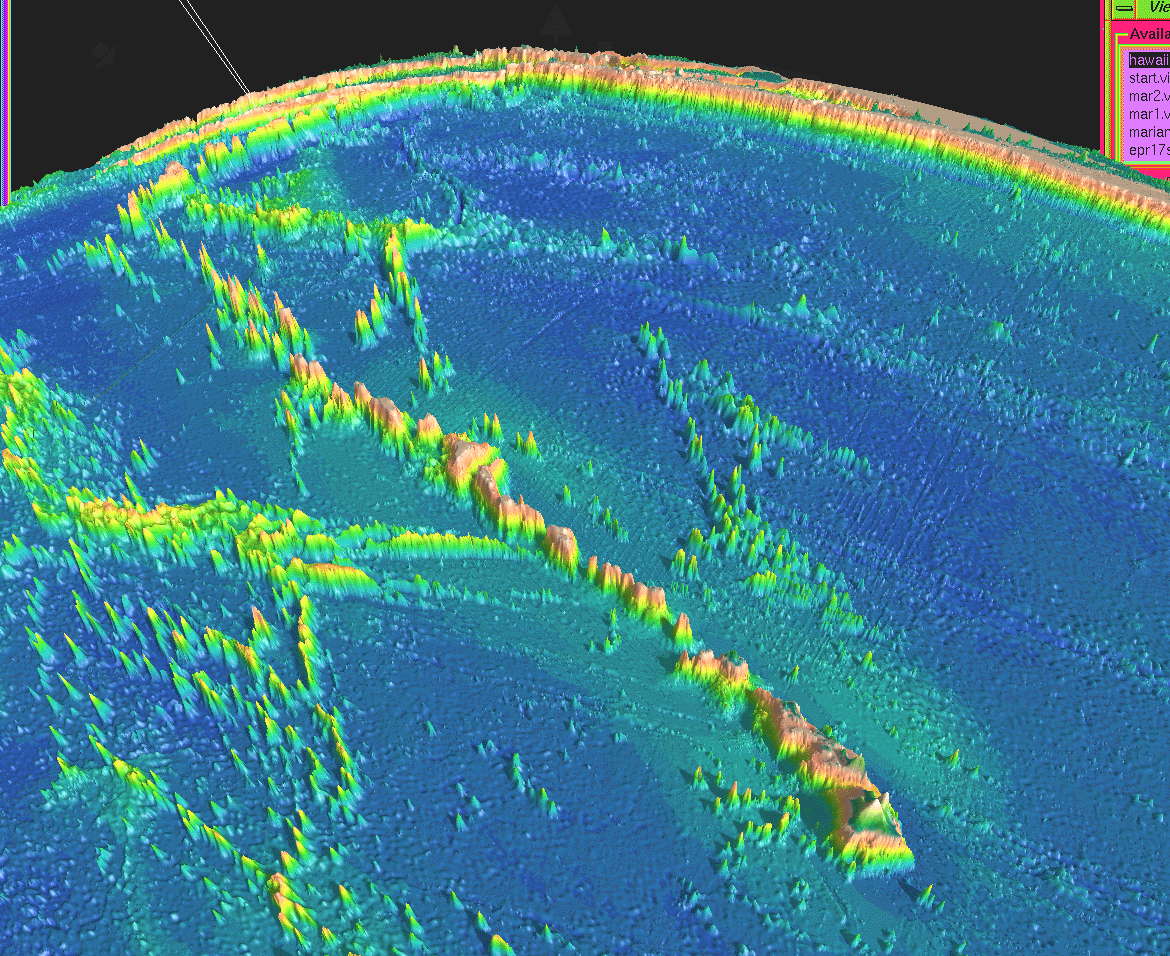 Hawaii-Emperor island/seamount chain.
The long line of seamounts are shield volcanos that once grew
to heights above sea level while they were positioned above the Hawaii hotspot.
As each volcano drifted to the northwest with the Pacific plate, it moved
away from the mantle hotspot and became extinct. Waves and weather
eroded the extinct volcanos and cooling of the underlying seafloor
caused each volcano to subside (over a period of millions of years) beneath the
waves. The line of seamounts associated with the Hawaii hotspot is the best
known hotspot track on Earth.
Hawaii-Emperor island/seamount chain.
The long line of seamounts are shield volcanos that once grew
to heights above sea level while they were positioned above the Hawaii hotspot.
As each volcano drifted to the northwest with the Pacific plate, it moved
away from the mantle hotspot and became extinct. Waves and weather
eroded the extinct volcanos and cooling of the underlying seafloor
caused each volcano to subside (over a period of millions of years) beneath the
waves. The line of seamounts associated with the Hawaii hotspot is the best
known hotspot track on Earth.
Most volcanos that are located above subducting plates are stratovolcanos,
of which several excellent examples are shown above.
Flood basalts are voluminous outpourings
of sheets of basaltic magmas that are believed to originate when the head
of a mantle hotspot (or plume) first arrives beneath the base of a plate.
Examples include the Columbia River Plateau basalts and the Deccan Trap basalts
of southern India. There are presently no active flood basalt provinces.
III. Edifice building
and dissection
- Building a volcanic
edifice
An active volcano can
build itself in a few thousand years (or longer). Given that the highest stratovolcanos
are more than 22,000 feet high (in the Andes), the rate at which they can
increase in height is rather impressive. By their nature, most volcanos
build themselves from the top down. Material is ejected from the central
vent at or near the volcanic peak, and gravity brings it down the slopes.
The processes by which a volcano builds its edifice depends on the type of
volcano. For example, stratovolcanos and shield volcanos build from the
top downwards. In contrast, lava that flows from cinder cones is emitted
from its sides or near its base (for reasons described above). Volcanic debris
is transported onto the surrounding area through direct eruption, wind and
water, and landslides from the flanks of the volcano.
Taking it down
The lifetime of a volcano on the landscape
is less than that of most mountains for two reasons.
1) Stratovolcanos often self-destruct.
During large eruptions, a volcano sometimes ejects so much material from
its interior magma chamber that too little material is left inside to support
the edifice of ejected material that comprises the material. In these instances,
the edifice can collapse downwards, i.e. the volcano caves in. Such a collapse
forms a caldera.
These collapses can occasionally remove thousands of feet of material from
the top of a volcanic edifice.
In addition to caldera formation, mass
wasting in the form of landslides can also remove significant material from
the flank of a volcano. Such landslides can be initiated by volcanic or tectonic
earthquakes prior to an eruption, which appears to be what happened in the
1980 eruption of Mount St. Helens, or they can initiate an eruption since
they suddenly remove large amounts of material that sustained pressure on
the magma chamber (this process is analogous to removing a champagne cork
- pressurized gas in the champagne explodes once the "plug" is removed).
2) Most volcanos by their very
nature are poorly constructed and top-heavy. They are built from the top
down of loose pyroclasts interleaved with lava flows. Consequently, they
are gravitationally unstable and prone to mass wasting events if they are
rained on or destabilized by a small eruption or earthquake. For example,
4300 years ago,the ancestor to the volcano shown in the figure above collapsed
downward onto the surrounding countryside. Its collapse spawned the largest
known subaerial debris flow in history. Volcanic material from the landslide
traveled 75 miles and buried parts of the countryside to depths of 650 feet.
In all, the slide covered approximately 900 square miles, an area the size
of Dane County. The volcanic edifice has rebuilt itself; however, hundreds
of thousands of people now live directly on the land slide that once devastated
the countryside.
Not surprisingly, what remains of a volcano
long after the poorly consolidated material ejected out of the cone has eroded
away is its erosion-resistant central plug. Ship Rock in New Mexico and Devil's
Tower in Wyoming are excellent examples.
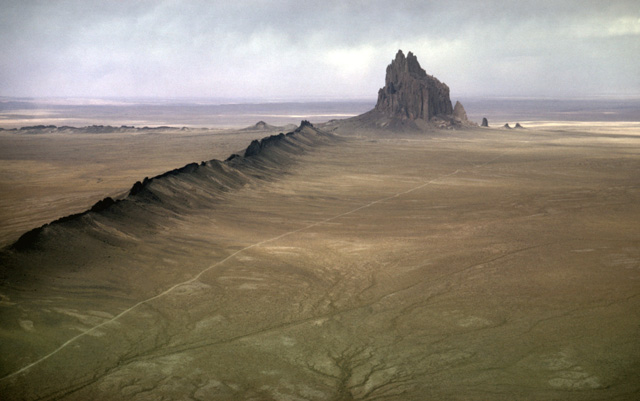
Ship Rock,
New Mexico. Photo from Geology by Light Plane
Web site - Prof. emeritus Lou Maher
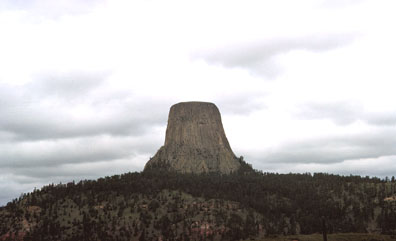
Devil's Tower, Wyoming
For superb aerial photos of this feature, go to "Geology by Light Plane"
Web site
In many senses, volcanos are short-lived
geological features, with lifetimes that typically measure hundreds of thousands
or a few millions of years. Nonetheless, at any given time, the Earth's landscape
is dotted with thousands of volcanos and they are amongst the most fascinating
and memorable features on the Earth's surface.
Return
to syllabus 
 Mount St. Helens before the May
18, 1980 eruption
Mount St. Helens before the May
18, 1980 eruption Mount St Helens after May 18, 1980
Mount St Helens after May 18, 1980 Post-eruption dome in crater of
Mount St. Helens Oregon
Post-eruption dome in crater of
Mount St. Helens Oregon Volcan Fuego de Colima, Mexico
Volcan Fuego de Colima, Mexico Aleutian
island stratovolcano
Aleutian
island stratovolcano Mt. Fuji, Japan
Mt. Fuji, Japan Mount
Pinatubo, Philippines, 1991
Mount
Pinatubo, Philippines, 1991 Shield
volcanos in the Galapagos, Ecuador. Note profile of another shield volcano
in the distance.
Shield
volcanos in the Galapagos, Ecuador. Note profile of another shield volcano
in the distance.  La Poruna monogenetic cinder cone, northern Chile
La Poruna monogenetic cinder cone, northern Chile Cinder cone field with flow
Cinder cone field with flow Erupting cinder cone
Erupting cinder cone This image shows the Paricutin cinder cone of western Mexico.
This cinder cone was "born" on Feb. 20, 1943, in the field of a poor Mexican
peasant who was planting corn when he saw flames begin shooting out of
a nearby crack in the ground. Within several years, Paricutin grew to a height of
more than 1000 feet years. For a time, it was Mexico's main tourist attraction.
Although Paricutin's eruptions consisted mainly of cinders for several years,
it eventually emitted a lava flow that covered dozens of square miles of the
surrounding countryside. Only nine years after eruptions initiated, Paricutin
went extinct and has remained inactive since 1952.
This image shows the Paricutin cinder cone of western Mexico.
This cinder cone was "born" on Feb. 20, 1943, in the field of a poor Mexican
peasant who was planting corn when he saw flames begin shooting out of
a nearby crack in the ground. Within several years, Paricutin grew to a height of
more than 1000 feet years. For a time, it was Mexico's main tourist attraction.
Although Paricutin's eruptions consisted mainly of cinders for several years,
it eventually emitted a lava flow that covered dozens of square miles of the
surrounding countryside. Only nine years after eruptions initiated, Paricutin
went extinct and has remained inactive since 1952. Satellite radar image of cinder cones in the Kamchatka
peninsula, Russia. Recent lava flows (now hardened) are exhibited by
reddish colors. The cones looks smooth because the radar waves that
are used to image them cannot image the individual cinders. In aggregate,
the numerous small cinders instead look like a smooth surface to the radar
wave.
Satellite radar image of cinder cones in the Kamchatka
peninsula, Russia. Recent lava flows (now hardened) are exhibited by
reddish colors. The cones looks smooth because the radar waves that
are used to image them cannot image the individual cinders. In aggregate,
the numerous small cinders instead look like a smooth surface to the radar
wave. Mono Craters, California
Mono Craters, California
 Hawaii-Emperor island/seamount chain.
The long line of seamounts are shield volcanos that once grew
to heights above sea level while they were positioned above the Hawaii hotspot.
As each volcano drifted to the northwest with the Pacific plate, it moved
away from the mantle hotspot and became extinct. Waves and weather
eroded the extinct volcanos and cooling of the underlying seafloor
caused each volcano to subside (over a period of millions of years) beneath the
waves. The line of seamounts associated with the Hawaii hotspot is the best
known hotspot track on Earth.
Hawaii-Emperor island/seamount chain.
The long line of seamounts are shield volcanos that once grew
to heights above sea level while they were positioned above the Hawaii hotspot.
As each volcano drifted to the northwest with the Pacific plate, it moved
away from the mantle hotspot and became extinct. Waves and weather
eroded the extinct volcanos and cooling of the underlying seafloor
caused each volcano to subside (over a period of millions of years) beneath the
waves. The line of seamounts associated with the Hawaii hotspot is the best
known hotspot track on Earth.